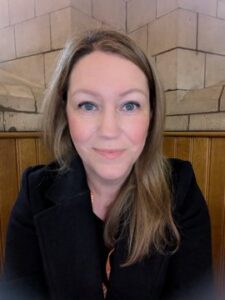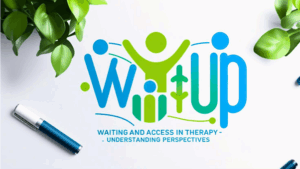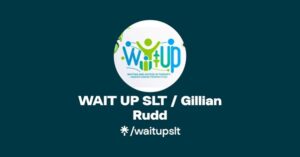This week’s blog is written by DHealth candidate, and Senior Lecturer, Gillian Rudd from Birmingham City University. Gill’s blog is about her DHealth study WAIT-UP SLT: Exploring Experiences of Waiting within Children’s Speech and Language Therapy.
Communication is a human right
Speech and language therapists are allied health professionals who support people of all ages with communication and swallowing difficulties (RCSLT, nd). Communication is essential to humanity, enabling us to express ourselves, connect with others and participate in the world in a meaningful way (McEwin and Santow, 2018). The right to freedom of opinion and expression has been recognised internationally for over 50 years (McLeod, 2018).
When people experience an impairment in their communication, it can affect their activity, participation and wellbeing across a range of domains (McCormack et al, 2018). Individuals with communication disabilities can be more at risk of abuse (Marshall and Barrett, 2017) and children with communication disabilities are at particular risk of not being heard (Gallagher et al, 2018; Gillett-Swan and Sargeant, 2018). Dysphagia (eating and drinking difficulties) can have wide-ranging impacts on mortality and quality of life. Dysphagia in children may result in failure to thrive, aspiration pneumonias, gastroesophageal reflux and/or the inability to establish and maintain proper nutrition and hydration (Prasse and Kikano, 2009). Quality of life can be affected through embarrassment and reduced enjoyment of food with “profound social consequences” for individuals and their families (RCSLT, 2015).
A Cinderella service
Despite an established need for support, there are longstanding concerns about the availability of and access to speech and language therapy (SLT) services. A ‘Cinderella service’ (Law, 2019), SLT is a ‘postcode lottery’ (Children’s Commissioner, 2019; I CAN and RCSLT, 2018; RCSLT, 2025) with children and families receiving very different types and amount of input depending on the area in which they live. Only 15% of respondents to a 2018 survey by I CAN and RCSLT felt that SLT was available for children and young people as required. Although the issues are longstanding, the situation has been further exacerbated by the pandemic (Dearden, 2022; Kessler and Boaz, 2024; RCSLT, 2021; RCSLT, 2022; RCSLT and ASLTIP, 2022), with services disrupted by staff sickness, difficulties accessing families and staff redeployment. SLT service managers have reported that “staff vacancy rates have risen to levels that they have never seen before” (RCSLT, 2023) and waiting lists are ‘spiralling’ (Deakin and Reynolds, 2022) as ‘demand is outstripping supply’ (Staufenberg, 2022).
Waiting in speech and language therapy
The latest available data from NHS England (2025) shows that 68,185 children and young people were waiting for speech and language therapy support in May 2025. To give a sense of scale to that number:
- There are 49,902 children’s nurses in England (NMC, 2025) and 20,148 speech and language therapists across the whole of the UK (HCPC, 2025)
- Anfield Stadium has a capacity of 61,276 (Liverpool FC, 2024) and Tottenham Hotspur Stadium has a capacity of 62,850 (Tottenham Hotspur, 2025)
6,923 children and young people have been waiting over a year and 1,189 have been waiting over 2 years for support. These figures relate to the waits for first appointments but we know that individuals accessing healthcare wait at multiple points during their journey, including for further assessments, onward referrals and treatment (McIntyre and Chow, 2020); data relating to these waits is often not recorded, and when it is, it is not made publicly available.
WAIT-UP SLT
Although waiting is “at the centre of experiences and practices of healthcare”, “we know very little about the relationship between the subjective experiences of patients who wait in and for care, health practitioners who ‘prescribe’ and manage waiting, and how this relates to broader cultural meanings of waiting” (Bar-Haim et al, 2023, p1). WAIT-UP SLT (Waiting and Access In Therapy: Understanding Perspectives in Speech and Language Therapy) seeks to address this gap through a multi-phase exploration of the experiences and views of:
- speech and language therapy teams
- parents and caregivers
- children and young people
A participatory research approach is being used, centring the value of genuine and meaningful participation, using “systematic inquiry in direct collaboration with those affected by an issue being studied for the purpose of action or change” (Vaughn and Jacquez, 2020, p1). Within participatory research, it is argued that change is not something that occurs at the end of a project, instead it “emerges from the process of researching together and the interactions amongst those involved” (ICPHR, 2020). Partnerships are therefore central to this work and so I am currently recruiting advisory group members engage in a co-productive process, influencing the design, development, evaluation and dissemination of the research.
Maximising Accessibility
Most research is locked behind paywalls or written in language that’s hard to understand—even for professionals. To challenge this and make the project more accessible, updates about WAIT-UP SLT will be shared widely across multiple platforms, including Blogger, Instagram, X (formerly Twitter), and LinkedIn. If you’re interested, please take a look and share with others. And if you know of other channels where this work could reach people, I’d love to hear your suggestions.
References
Bar-Haim, S., Baraitser, L. and Moore, M.D. (2023) The shadows of waiting and care: on discourses of waiting in the history of the British National Health Service. WellcomeOpen Research, 8 (73), 1-21. https://doi.org/10.12688/wellcomeopenres.18913.1
Bercow, J. (2008) The Bercow Report: A review of services for children and young people (0-19) with speech, language and communication needs. Available at: https://webarchive.nationalarchives.gov.uk/ukgwa/20130321005340/https://www.education.gov.uk/publications/standard/publicationdetail/page1/DCSF-00632-2008 [Accessed 01 August 2025]
Children’s Commissioner (2019) We need to talk: Access to speech and language therapy. Available at: https://www.childrenscommissioner.gov.uk/report/we-needto-talk/ [Accessed 01 August 2025]
Deakin, M and Reynolds, D. (2022) Urgent focus needed on backlogs in children and young people’s services. NHS Providers. Available at: https://nhsproviders.org/news-blogs/blogs/urgent-focus-needed-on-backlogs-in-children-and-young-peoples-services [Accessed 01 August 2025]
Dearden, C. (2022) Speech therapy: Covid had ‘devastating’ effect on children. BBC News: 22 March 2022. Available at: https://www.bbc.co.uk/news/uk-wales-60904214 [Accessed 01 August 2025]
Gallagher, A.L., Tancredi, H. and Graham, L.J. (2018) Advancing the human rights of children with communication needs in school. International Journal of Speech-Language Pathology, 20 (1), 128-132, DOI: 10.1080/17549507.2018.1395478
Gillett-Swan, J. and Sargeant, J. (2018) Assuring children’s human right to freedom of opinion and expression in education. International Journal of Speech-Language Pathology, 20 (1), 120-127, DOI: 10.1080/17549507.2018.1385852
HCPC (2025) Registrant snapshot – 1 April 2025. Available at: https://www.hcpc-uk.org/resources/data/2025/registrant-snapshot-april-2025/ [Accessed 01 August 2025]
I CAN and RCSLT. (2018). Bercow: Ten Years on an Independent Review of Provision for Children and Young People With Speech, Language and Communication Needs in England. London: ICAN/RCSLT. Available at: https://www.bercow10yearson.com/ [Accessed 01 August 2025]
Kessler, I., & Boaz, A. (2024). The Demand and Supply of Therapists for Children and Young People with Special Educational Needs and Disabilities: A Scoping Study. King’s College London: NIHR Policy Research Unit in Health and Social Care Workforce, The Policy Institute. https://doi.org/10.18742/pub01-181
Law, J. (2019) Perspective: The Changing Perception of Communication Needs—A Litmus Test for the Warnock Legacy. Frontiers in Education. Available at: https://www.frontiersin.org/articles/10.3389/feduc.2019.00042/full [Accessed 01 August 2025]
Liverpool FC (2024) New Anfield capacity confirmed ahead of 2024-25. Available at: https://www.liverpoolfc.com/news/new-anfield-capacity-confirmed-ahead-2024-25 [Accessed 01 August 2025]
Marshall, J. and Barrett, H. (2017): Human rights of refugee-survivors of sexual and gender-based violence with communication disability. International Journal of Speech-Language Pathology, DOI: 10.1080/17549507.2017.1392608
McCormack, J., McLeod, S., Harrison, L.J. and Holliday, E.L. (2022) Drawing Talking: Listening to Children With Speech Sound Disorders. Language, Speech and Hearing Services in Schools, 53 (3): 713-731. doi: 10.1044/2021_LSHSS-21-00140.
McEwin, A. and Santow, E. (2018) The importance of the human right to communication. International Journal of Speech-Language Pathology, 20, 1-2. https://doi.org/10.1080/17549507.2018.1415548
McIntyre, D. and Chow, C.K. (2020) Waiting Time as an Indicator for Health Services Under Strain: A Narrative Review. The Journal of Health Care Organization, Provision and Financing, 57, 1-15. https://doi.org/10.1177/0046958020910305
McLeod, S. (2018) Communication rights: Fundamental human rights for all. International Journal of Speech-Language Pathology, 20 (1), 3-11. http://dx.doi.org/10.1080/17549507.2018.1428687
NHS England (2025) Community health services waiting lists. Available at: https://www.england.nhs.uk/statistics/statistical-work-areas/community-health-services-waiting-lists/ [Accessed 01 August 2025]
Nursing and Midwifery Council (2025) The NMC register England 1 April 2024-31 March 2025. Available at: https://www.nmc.org.uk/globalassets/sitedocuments/data-reports/march-2025/england-data-report-march-2025.pdf [Accessed 01 August 2025]
Prasse J.,E. and Kikano, G.E. (2009) An Overview of Pediatric Dysphagia. Clinical Pediatrics, 48 (3), 247-251. doi:10.1177/0009922808327323
RCSLT (nd) Speech and Language Therapy. Available at: https://www.rcslt.org/speech-and-language-therapy/ [Accessed 01 August 2025]
RCSLT (2021) Speech and language therapy during and beyond COVID-19: building back better with people who have communication and swallowing needs. Available at: https://www.rcslt.org/wp-content/uploads/2021/03/Building-back-better-March2021.pdf [Accessed 01 August 2025]
RCSLT (2022) Urgent action needed to meet growing healthcare demand. Available at: https://www.rcslt.org/news/urgent-action-needed-to-meet-growing-demand/ [Accessed 01 August 2025]
RCSLT (2023) Tell us about your vacancy and recruitment issues. Available at: https://www.rcslt.org/news/tell-us-about-your-vacancy-and-recruitment-issues/ [Accessed 01 August 2025]
RCSLT (2025) A profession under pressure: speech and language therapy retention and waiting times (July 2025). Available at: https://www.rcslt.org/wp-content/uploads/2025/07/A-profession-under-pressure-SLT-retention-and-waiting-times.pdf [Accessed 20 July 2025]
RCSLT and ASLTIP (2022) Getting it right for communication – right support, right place, right time: our response to the Department for Education’s SEND Review Green Paper July 2022. Available at: https://www.rcslt.org/wp-content/uploads/2022/07/RCSLT-and-ASLTIP-policy-statement-on-SEND-Green-Paper_FINAL-for-web.pdf [Accessed 01 August 2025]
Staufenberg, J. (2022) Speech and language therapists ‘completely booked out’. SchoolsWeek. Available at: https://schoolsweek.co.uk/speech-and-language-therapists-completely-booked-out/ [Accessed 01 August 2025]
Tottenham Hotspur (2025) Stadium Events and Information Guide. Available at: https://www.tottenhamhotspur.com/the-stadium/local/#:~:text=With%20a%20capacity%20of%2062%2C850,of%20other%20events%20and%20concerts. [Accessed 01 August]
Vaugn, L.M. and Jacquez, F. (2020) Participatory research methods – choice points in the research process. Journal of Participatory Research, 1 (1). https://doi.org/10.35844/001c.13244


